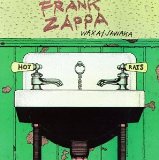With the Fourth of July upon us, it seems an appropriate time to celebrate a unique American music: jazz. So, you wonder, why is this post about Frank Zappa? The vast majority of the uninitiated think Zappa was just a weird rock musician. In point of fact, he was a too often unheralded explorer of the jazz fusion idiom. In fact, he might even be considered one of its pioneers.
 Zappa first really explored jazz-rock with his 1969 solo album, Hot Rats. That record came just a few months after Miles Davis released In a Silent Way, which represented his immersion into fusion. On July 5, 1972, Zappa confirmed his interest in the genre with the release of Waka/Jawaka.
Zappa first really explored jazz-rock with his 1969 solo album, Hot Rats. That record came just a few months after Miles Davis released In a Silent Way, which represented his immersion into fusion. On July 5, 1972, Zappa confirmed his interest in the genre with the release of Waka/Jawaka.
Some refer to Waka/Jawaka as “Hot Rats II,” not only because of the music but the faucets on the water taps on the cover read “Hot” and “Rats.” This album, though, came at a rougher time in Zappa’s life. In December 1971, Zappa was pushed from a stage in London, resulting in a month in the hospital and a year in a cast or wheelchair. Because of his physical limitations, he spent quite a bit of time in the studio and the results indicated he’d certainly been listening to Miles, who had added the best-selling Bitches Brew and A Tribute to Jack Johnson to his fusion catalog.
The influence is seen in the opening cut of Waka/Jawaka, recorded in large part with studio musicians. “Big Swifty,” which took up the entire first side of the original LP, echoes what Davis was doing. Part of the resemblance is undoubtedly due to trumpeter Sal Marquez, who’d previously played with both Buddy Rich and Woody Herman. Still, the instrumental piece left little doubt Zappa still had the jazz-rock bug and was very adept at it. If anything, he’d taken it a step further and gave it more of a big band feel with his studio soundboard skills. That did, however, impact the tune a bit. Although technically excellent, the tune is slightly lacking in improvisational energy.
For whatever reason, side two opens with what I consider a couple throw away tunes. “Your Mouth” is a blues-based tune that is closer to more standard Mothers fare. “It Just Might Be A One-Shot Deal” is similar, but also imported not only jazz but both rock and country feel thanks to a pedal steel performance from “Sneaky Pete” Kleinow from The Flying Burrito Brothers. The two songs feature vocals but, combined, are less than half the length of “Big Swity” and nearly five minutes shorter than the title cut, which closes the album.
The instrumental title cut demonstrated Zappa was not influenced by Davis alone. It has a more big band feel and echoes the rock end of the jazz-rock movement, be it early Chicago, some BS&T or even The Flock. Here, Zappa includes not just Marquez on trumpet but two trombone/baritone players, as well sax, piccolo and flute. At the same time, the tune remains more Zappaesque than “Big Swifty,” although the latter would tend to be performed on subsequent tours.
Significantly, Waka/Jawaka was not Zappa’s last foray into fusion. Just four months later he would release The Grand Wazoo, which further explored the idiom with an even bigger ensemble. In fact, the title cut used 11 woodwind and brass players. Thus, in the space of three years, three solo Zappa albums explored jazz through the concept of rock. Zappa’s estate has done an excellent job monitoring his music and releasing various recordings. Hopefully, some day it will provide us with a Zappa jazz collection.
Jazz: The Music of Unemployment.
Subheading in Frank Zappa, The Real Frank Zappa Book







